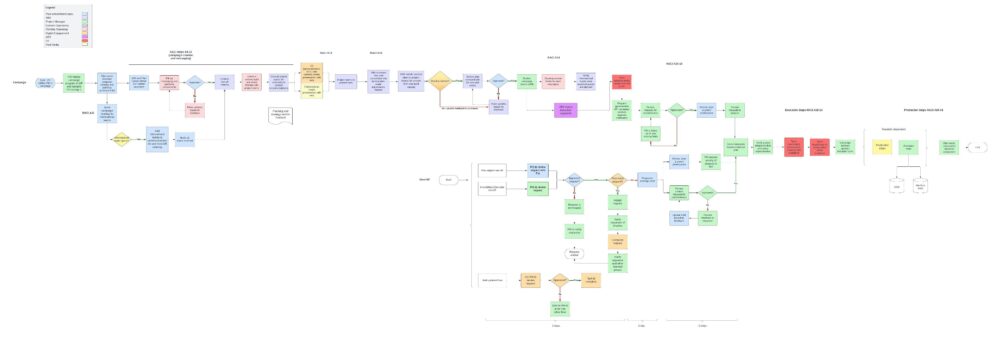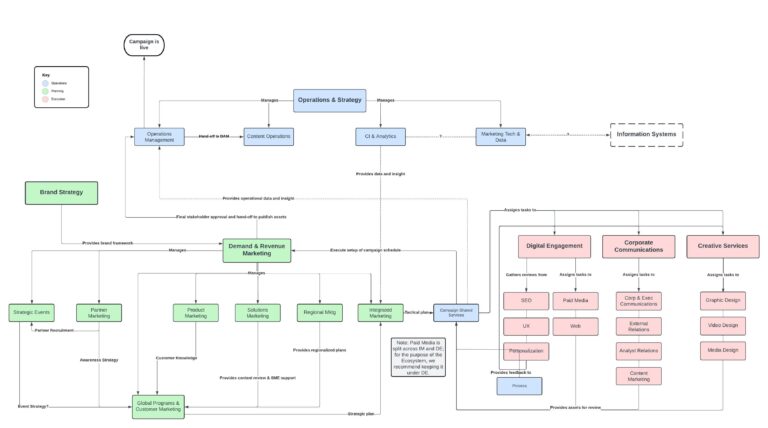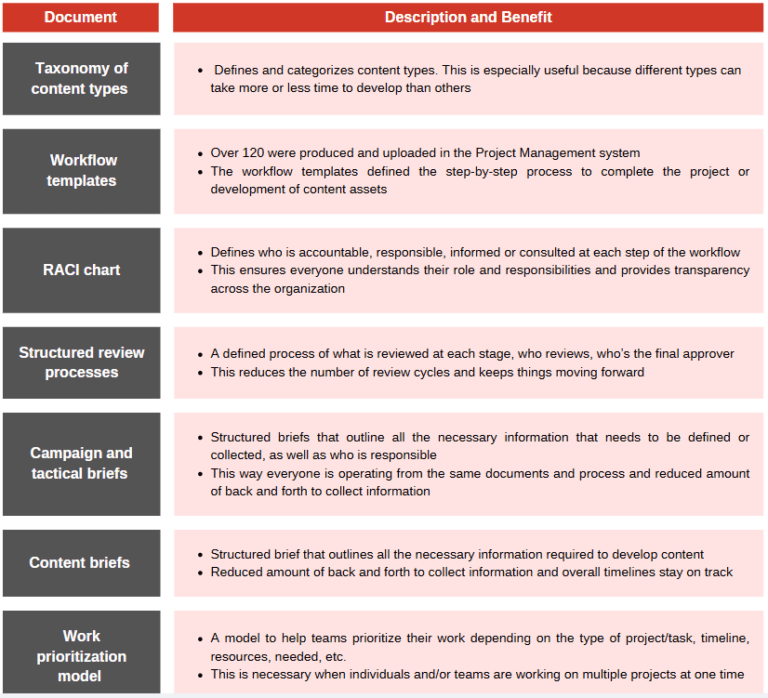Case Study:
The Power of Marketing Orchestration
How a global SaaS company accelerated time-to-market, boosted team productivity, and scaled operations with an integrated workflow
Introduction
Our multinational SaaS client struggled to create an effective streamlined workflow for years. They wanted to completely overhaul their campaign planning to execution process.
With global operations and a 200-person marketing team they were facing a multitude of issues that kept them from working efficiently and getting to market on time. There were significant cross-functional breakdowns in communication, frequent changes to work causing delays, and growing complexity with the introduction of new teams and changing project management platforms.
This is not a unique issue. In fact, Gartner found 84% of marketers experience high ‘Collaboration Drag’ due to the complexity of cross-functional work caused by longer buying cycles and larger buying committees. All of which makes the internal process for marketing and sales more complicated.
That’s where marketing orchestration comes in. At the start of the engagement, we developed a game plan for extensive discovery including a two-day onsite workshop to really immerse ourselves in their process and to understand the pain points with their current workflow. We provided an effective, streamlined approach to get to market. Efforts and teams were coordinated and realigned, roles and responsibilities were clarified, resulting in work being done more efficiently.
In addition, change management was a key piece of the engagement, especially given the large size of the GTM team. We developed a customized approach to ensure each team was involved in the process, from providing feedback to reviewing the frameworks and workflows being developed. Lastly, extensive training and testing was vital to ensure the success of the workflow for the client.

Go-to-Market Challenges
Our SaaS client was facing numerous challenges that kept them from working efficiently, delivering on-time and being a productive, cohesive team.
The key challenges were:
- Complex Team Structure: Large marketing team across numerous functions, business units, geographies, and leadership.
- Previous Failures and Change Fatigue: Multiple failed attempts to create a planning-to-execution workflow. This resulted in change fatigue and lack of trust in other teams/leadership.
- Cross-Functional Communication Issues: There were strong processes within teams, but significant breakdowns between teams, particularly between planning and execution teams.
- Frequent Changes to Work: Planning teams frequently changed details late, negatively impacting execution capacity and timelines.
- Inconsistent Work Requests: Planning teams did not provide consistent information necessary for execution. Resulting in back-and-forth communication, which slowed down projects.
- Growing Complexity: Introduction of new teams and changing project management platforms added further challenges.
Each challenge was carefully considered and addresses properly with all internal stakeholders through the workflow development process. This built trust between us, and everyone involved in the engagement, which in turn led to rebuilding trust between the teams and leadership.
Based on an audit of our clients, we found that the majority struggle with undefined roles and unarticulated expectations and processes the most.
Our Framework for Seamless Marketing Orchestration
Our approach to Marketing Orchestration consists of four key components:
- Strategic Alignment & Planning: Goal frameworks, targeting and theming, budgeting, briefing process
- Roles & Process: Planning to execution workflow, RACI, ecosystems and org charts
- Project Management Tools: Templates, data requirements, budget allocation, tech stack
- Communication & Collaboration: Key hand-off processes, SLAs, meeting cadences, communication channels, process documentation
We used these four components to categorize the issues and challenges the customer was facing. From there we can formulate a tailored strategy to address each challenge effectively.
The tailored strategy for this client included:
Discovery Phase: In-depth analysis via an onsite workshop and interviews, to identify the root causes of communication and workflow breakdowns. We presented our findings to senior marketing leaders, with the goal of driving additional supporting changes, while we worked on the workflow.
Workflow Mapping: We held collaborative working sessions to design a comprehensive, logical timeline for campaign planning and execution. This included key communication points, supporting documentation, and structured processes.

Workflow diagram for the campaign to execution process.
Ecosystem Chart: Documents how different teams, functions, and departments work together throughout the campaign planning to execution process. A helpful visual to see where communication needs to happen.
Ecosystem diagram we developed to document how teams, functions, and departments work together throughout the process.
Change Management: Consisted of engagement with stakeholders, training sessions, and structured testing of the new process. In addition, to ensure effective change management we:
- Developed structured communication plans to all levels of the marketing organization and stakeholders
- Engaged leadership as key sponsors throughout the engagement
- Ensured alignment from top-down
- Assessed risks and surfaced potential issues to leadership so they could be dealt with
- Assessed organizational readiness and the ability of both the organization’s operations and culture to adopt new processes
- Supported implementation of the new Project Management tool
- Developed and implemented testing plans to fix bugs prior to a full launch
- Initially tested a portion of the workflow with a small team (i.e., developing a content asset)
- Held weekly check-ins to document and discuss issues or bottlenecks
- Implemented fixes during the test
- Reviewed workflow post-test to implement broader changes and communicate them to the broader team, once finalized
Supporting Documentation: Below is the additional documentation we developed to support the campaign planning-to-execution workflow.
“Engaging teams early in the process allowed us to gain their trust and buy-in. We listened to their concerns and asked for their feedback, keeping what worked and improving on what wasn’t.”
Streamlined GTM Motion and Productive Teamwork
We were able to successfully implement a fully integrated, scalable campaign planning-to-execution workflow with the following results:
- Consistency and Predictability of Work: Key for accurate capacity planning, ensuring quality, and retaining talent.
- Improved Communication: Ensured cross-team communication was seamless and predictable.
- Trackable SLAs: Developed systems for managing and tracking work with clear SLAs.
- Sustainable, Scalable Process: Created a process that would allow for future iterative improvements, rather than full reboots, as the organization continues to grow
- Better Team Integration: Newly added and longstanding teams alike were able to have far greater clarity and more efficient operations.
- Iterative Setup: The process was set up to avoid reboots and focus on iterative improvements into the future.
- Productive Workforce: Teams are more productive with a realistic view of capacity and resources. Better work is produced with greater efficiency and overall moral improved.
In addition, there were a handful of improvements to the client’s overall workflow management process and team morale including:
- All work routed through consistent intakes, allowing for predictability and prioritization of work.
- Implemented a testing protocol to identify and resolve bugs, solving numerous communication issues.
- Ensured buy-in across the marketing organization.
- Improved activation of Workfront for PMing both internal and external teams.
- Improved overall project management integration into marketing processes.
- Clarified the complexity of their marketing efforts and team structure.

We’ve seen firsthand how quickly complexity can escalate. Many moving parts, high internal visibility, and intricate team structures often lead to challenges in coordination and execution. While there isn’t a one-size-fits-all solution, we’ve identified key best practices that increase time to market, supports scalability, and enables a productive (and happy) workforce.

